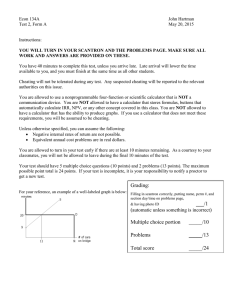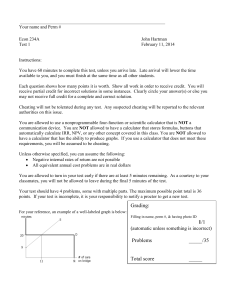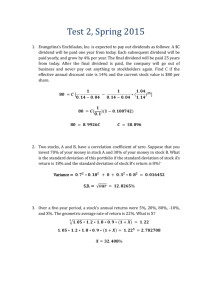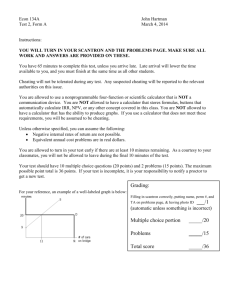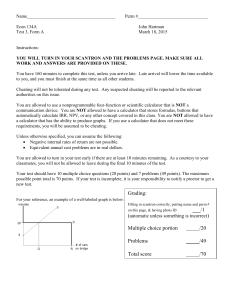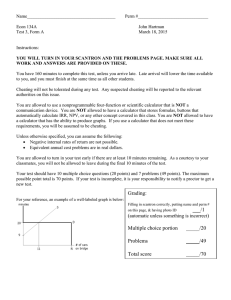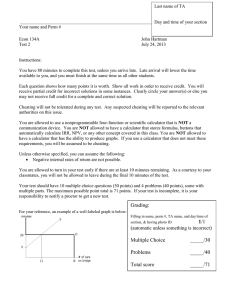here
advertisement
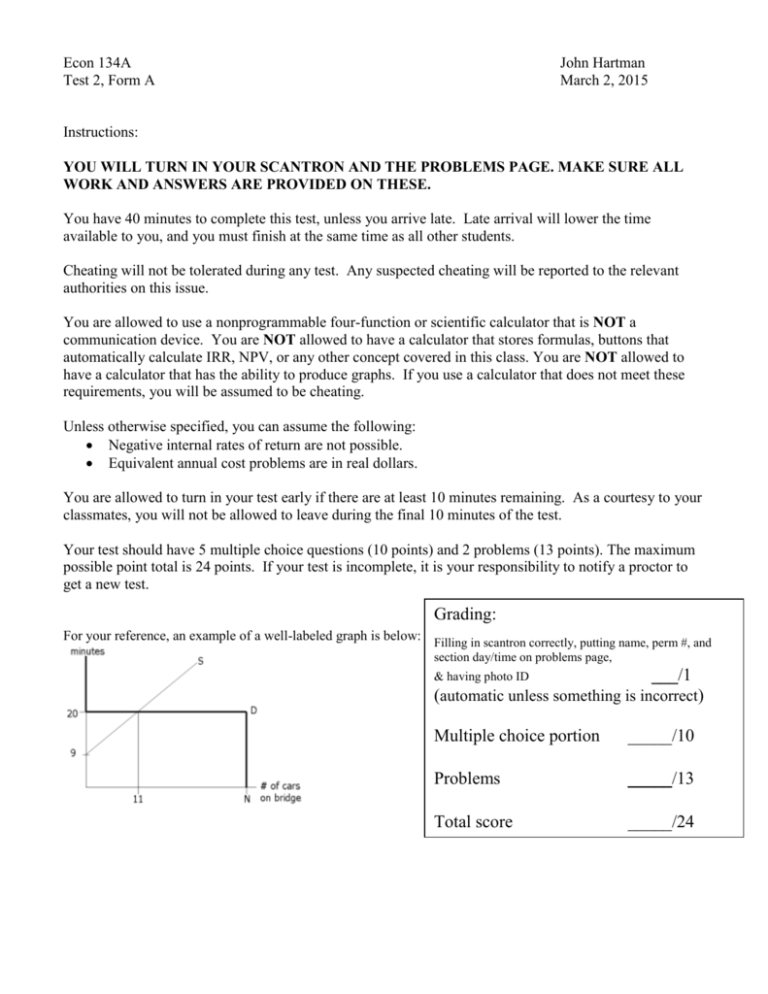
Econ 134A
Test 2, Form A
John Hartman
March 2, 2015
Instructions:
YOU WILL TURN IN YOUR SCANTRON AND THE PROBLEMS PAGE. MAKE SURE ALL
WORK AND ANSWERS ARE PROVIDED ON THESE.
You have 40 minutes to complete this test, unless you arrive late. Late arrival will lower the time
available to you, and you must finish at the same time as all other students.
Cheating will not be tolerated during any test. Any suspected cheating will be reported to the relevant
authorities on this issue.
You are allowed to use a nonprogrammable four-function or scientific calculator that is NOT a
communication device. You are NOT allowed to have a calculator that stores formulas, buttons that
automatically calculate IRR, NPV, or any other concept covered in this class. You are NOT allowed to
have a calculator that has the ability to produce graphs. If you use a calculator that does not meet these
requirements, you will be assumed to be cheating.
Unless otherwise specified, you can assume the following:
Negative internal rates of return are not possible.
Equivalent annual cost problems are in real dollars.
You are allowed to turn in your test early if there are at least 10 minutes remaining. As a courtesy to your
classmates, you will not be allowed to leave during the final 10 minutes of the test.
Your test should have 5 multiple choice questions (10 points) and 2 problems (13 points). The maximum
possible point total is 24 points. If your test is incomplete, it is your responsibility to notify a proctor to
get a new test.
Grading:
For your reference, an example of a well-labeled graph is below:
Filling in scantron correctly, putting name, perm #, and
section day/time on problems page,
& having photo ID
___/1
(automatic unless something is incorrect)
Multiple choice portion
_____/10
Problems
_____/13
Total score
_____/24
MULTIPLE CHOICE: Answer the following questions on your scantron. Each correct answer is worth 2
points. All incorrect or blank answers are worth 0 points. If there is an answer that does not exactly
match the correct answer, choose the closest answer.
1. At 8:00 am today, ABC Kraut, Inc. planned to pay a $5 dividend every year, starting one year from
today. At 2:00 pm, the company will revise its dividend to $4 per year, starting today. What will be the
change in the value of this stock today if the equilibrium price is always based on the company’s planned
dividend stream of payments? Assume a 10% effective annual discount rate.
A. Down by $10
B. Down by $6
C. No change
D. Up by $6
E. Up by $10
𝑷𝟖 𝒂𝒎 =
𝑪 𝟓
=
= $𝟓𝟎
𝒓 .𝟏
𝑪
𝟒
= 𝟒 + = $𝟒𝟒
𝒓
.𝟏
∆𝟖𝒂𝒎→𝟐 𝒑𝒎 = 𝑷𝟐 𝒑𝒎 − 𝑷𝟖 𝒂𝒎 = 𝟒𝟒 − 𝟓𝟎 = −$𝟔
𝑷𝟐 𝒑𝒎 = 𝑫𝟎 + 𝑷𝟏 = 𝑫𝟎 +
2. A zero-coupon bond is currently selling for $150. The bond will pay out $500 in 8½ years. What is the
stated annual interest rate if interest is compounded monthly?
A. 14.2%
B. 14.7%
C. 15.2%
D. 15.7%
E. 16.2%
𝑷𝟎 =
𝑫𝟖.𝟓
(𝟏 + 𝑬𝟏−𝒚𝒆𝒂𝒓 )
𝑬𝟏−𝒚𝒆𝒂𝒓
𝟖.𝟓
⟹ 𝟏𝟓𝟎 =
𝟓𝟎𝟎
(𝟏 + 𝑬𝟖.𝟓−𝒚𝒆𝒂𝒓𝒔 )
𝟖.𝟓
⟹ 𝑬𝟏−𝒚𝒆𝒂𝒓 ≈. 𝟏𝟓𝟐𝟐
𝑺𝟏−𝒚𝒆𝒂𝒓 𝒎
𝑺𝟏−𝒚𝒆𝒂𝒓 𝟏𝟐
) − 𝟏 ⟹. 𝟏𝟓𝟐𝟐 = (𝟏 +
) − 𝟏 ⟹ 𝑺𝟏−𝒚𝒆𝒂𝒓 ≈. 𝟏𝟒𝟐𝟓
= (𝟏 +
𝒎
𝟏𝟐
3. Two stocks’ rates of return have a correlation coefficient of 1. The expected rate of return for the first
stock is 5%, and the standard deviation of the return for this stock is 6%. The values for the second stock
are 8% and 15%, respectively. If you can invest a non-negative percentage in both stocks, and all of your
money must be invested in both assets, which of the following could be the minimum standard deviation
possible?
A. 15%
B. 8%
C. 6%
D. 5%
E. 0%
Because 𝝆 = 𝟏, the minimum standard deviation possible is the smallest standard
deviation of either stock, which is the first stock; therefore, the minimum standard
deviation is 6%.
4. Stock X has a beta of 1.5 and a rate of return of 17%. Stock Y has a beta of 0.25 and a rate of return of
7%. What is the market rate of return?
A. 10%
B. 11%
C. 12%
D. 13%
E. 14%
(𝑺𝑺 ) = 𝑹𝒇 + 𝛃𝐒 [𝑬(𝑹𝑴 ) − 𝑹𝑭 ]
∴, 𝑬(𝑺𝑿 ) = 𝑹𝒇 + 𝛃𝐗 [𝑬(𝑹𝑴 ) − 𝑹𝑭 ] ⟹. 𝟏𝟕 = 𝑹𝑭 + 𝟏. 𝟓[𝑬(𝑹𝑴 ) − 𝑹𝑭 ]
⟹ 𝑹𝑭 = 𝟑𝑬(𝑹𝑴 )−. 𝟑𝟒
∴, 𝑬(𝑺𝒀 ) = [𝟑𝑬(𝑹𝑴 )−. 𝟑𝟒] + 𝜷𝒀 {𝑬(𝑹𝑴 ) − [𝟑𝑬(𝑹𝑴 )−. 𝟑𝟒]}
⟹. 𝟎𝟕 = [𝟑𝑬(𝑹𝑴 )−. 𝟑𝟒]+. 𝟐𝟓{𝑬(𝑹𝑴 ) − [𝟑𝑬(𝑹𝑴 )−. 𝟑𝟒]} ⟹ 𝑬(𝑹𝑴 ) =. 𝟏𝟑
5. A stock’s rate of return over a 7-year period were 5%, –9%, 13%, –25%, 10%, 30%, and 3%. What is
the geometric average of the rate of return during this 7-year period?
A. 3.9%
B. 3.3%
C. 2.9%
D. 2.5%
E. 2.1%
𝑮𝑨 = 𝟕√(𝟏+. 𝟎𝟓)(𝟏−. 𝟎𝟗)(𝟏+. 𝟏𝟑)(𝟏−. 𝟐𝟓)(𝟏+. 𝟏)(𝟏+. 𝟑)(𝟏+. 𝟎𝟑) − 𝟏 ≈. 𝟎𝟐𝟓𝟓
Name___________________ Perm #____________ Day/time of section_____________________
For the following problems, you will need to write out the solution. You must show all work to
receive credit. Each problem (or part of problem) shows the maximum point value. Provide at least
four significant digits to each answer or you may not receive full credit for a correct solution. Show
all work in order to receive credit. You will receive partial credit for incorrect solutions in some
instances. Clearly circle your answer(s) or else you may not receive full credit for a complete and
correct solution.
6. (7 points) A stock pays dividends that are always one year apart. The stock will pay its next dividend
six months from today, in the amount of $2. The dividend will go up by 7% for each of the three
subsequent payments. After that, the dividend will remain constant forever. What is the present value of
the stock if the effective annual interest rate is 20%?
𝟔
𝟏
𝑬𝟔−𝒎𝒐𝒏𝒕𝒉 = (𝟏 + 𝑬𝟏−𝒚𝒆𝒂𝒓 )𝟏𝟐 − 𝟏 ⟹ 𝑬𝟔−𝒎𝒐𝒏𝒕𝒉 = (𝟏+. 𝟐)𝟐 − 𝟏 ≈. 𝟎𝟗𝟓𝟒
𝑪
𝒏
𝑬𝟏−𝒚𝒆𝒂𝒓
𝑪
𝟏+𝒈
[𝟏 − (
) ]} +
𝑷𝑽 = (𝟏 + 𝑬𝟔−𝒎𝒐𝒏𝒕𝒉 ) {
(𝟏 + 𝑬𝟔−𝒎𝒐𝒏𝒕𝒉 )𝟕
𝑬𝟏−𝒚𝒆𝒂𝒓 − 𝒈
𝟏 + 𝑬𝟏−𝒚𝒆𝒂𝒓
𝟐(𝟏. 𝟎𝟕)𝟑
𝟐
𝟏+. 𝟎𝟕 𝟒
.𝟐
[𝟏 − (
) ]} +
⟹ 𝑷𝑽 = (𝟏+. 𝟎𝟗𝟓𝟒) {
≈ $𝟏𝟐. 𝟔𝟕
(𝟏+. 𝟎𝟗𝟓𝟒)𝟕
. 𝟐−. 𝟎𝟕
𝟏+. 𝟐
7. Currently, a company is a cash cow, and the stock is worth $100 per share. It is discovered that 5 years
from now, the company could invest $1,000,000 into a project that will result in a $2,000,000 payment 12
years from now. The company must decide today, however, whether or not to invest in the project. The
company currently has 500,000 shares distributed, and the appropriate annual discount rate for this
company is 8%.
(a) (3 points) Should the company make this investment? You must support your answer completely to
receive any credit.
𝟏𝟎𝟎𝟎𝟎𝟎𝟎 𝟐𝟎𝟎𝟎𝟎𝟎𝟎
+
≈ $𝟏𝟏𝟑, 𝟔𝟒𝟒. 𝟑𝟐 > 𝟎
(𝟏+. 𝟎𝟖)𝟓 (𝟏+. 𝟎𝟖)𝟏𝟐
Yes, the company should invest in the project.
𝑵𝑷𝑽 = −
(b) (3 points) What will be the change in the present value of each share of stock today if the company
decides to make this investment?
Present value increases by $𝟏𝟏𝟑, 𝟔𝟒𝟒. 𝟑𝟐. Each share must increase by
𝟏𝟏𝟑𝟔𝟒𝟒𝟑𝟐
𝟓𝟎𝟎𝟎𝟎𝟎
≈ $. 𝟐𝟑.
